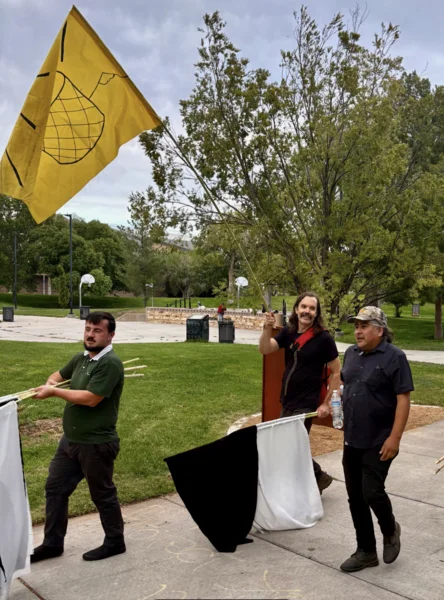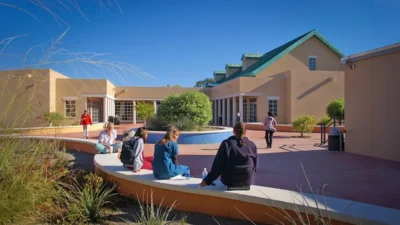However finely one may write about an event, it is the lived encounter that lends words their true gravity.
So, it was with Tiguex, Raven Chacon’s sprawling, city-wide composition—a work of many movements and many voices, unfolding like a symphony stitched into the very fabric of Albuquerque.
To follow each of its twenty parts would have required an impossible choreography: from mountain crest to city streets, from the Rio Grande River to neighborhood enclaves and a crowded plaza, all within a single day. Yet I was fortunate to step into a moment directly, while the whole resounded through the airwaves of KUNM and a live feed at Tiguez.com. What I heard—and what I experienced in person—was brilliance.
Tiguex resisted the familiar boundaries of performance. It was not a spectacle to be consumed but an invitation to participate, to dissolve the distance between stage and street. We were asked not only to observe but to contribute, to record our own traces and send them forth via KUNM, as though each listener became a note in Chacon’s unfolding score. In that collective gesture, community itself became the medium.
A letter to Albuquerque, Tiguex sometimes whispered softly, a lullaby of love (“Volcano Choir,” performed along one of Albuquerque’s Three sister volcanoes, Black, and “Cantata” sung under the I-40 freeway), other times it shrieked in despair (“The Lowest Point,” a brigade of drums performed at the National Museum of Nuclear Science and History).
My specific involvement led me to Movement XVII—Old Town (Procession III).
 Procession Participants | Photo: Brian C. Nixon
Procession Participants | Photo: Brian C. Nixon
At Robinson Park, a gathering assembled: families with children, elders in traditional dress, teenagers and middle-aged partakers, musicians (such as La Chat Lunatique’s Muni Kulasinghe) and poets (former Albuquerque poet-laurate Michelle Otero), were shoulder to shoulder with roughly 200 merry makers. Led by A Hawk and a Hacksaw’s Jeremy Barnes, we wound our way down through neighborhoods near Central Avenue—Route 66, the mythic artery of the Southwest—until we entered the timeworn plaza of Old Town. There, amid adobe walls and centuries of memory, the procession swelled into something at once ancient and new. And it is where the architect of the day, Raven Chacon, joined us.
 Jeremy Barnes and Raven Chacon Walking into Old Town | Photo: Brian C. Nixon
Jeremy Barnes and Raven Chacon Walking into Old Town | Photo: Brian C. Nixon
Even amidst cumulating storm clouds, the procession marched around the gazebo. Perhaps not all grasped the significance of the work, yet all seemed swept by its current. Smiles flared. Onlookers leaned from sidewalks to cheer and take photos. For a brief passage of time, the ordinary city dissolved into celebration, and we were citizens of a fleeting republic of sound. I offered my recording to KUNM (where one could upload sound bites) and surrendered to the wonder of it.
 A Hawk and a Hacksaw’s Jeremy Barnes leading the procession around the Old Town Gazebo | Photo: Brian C. Nixon
A Hawk and a Hacksaw’s Jeremy Barnes leading the procession around the Old Town Gazebo | Photo: Brian C. Nixon
Marvelous hardly suffices. Words stumble where experience soars. All I can say is this: in a day and age of turmoil and terror, we need more Tiguex’s.
To learn more about this historic composition, visit tiguex.com.
Brian C. Nixon, Ph.D., is Chief Academic Officer and professor at Veritas International University in Albuquerque. As a writer, musician, and artist, his interests surround the philosophical transcendentals: truth, beauty, and goodness. You can contact Brian via his Bandcamp email address: https://briancharlesnixon.bandcamp.com








